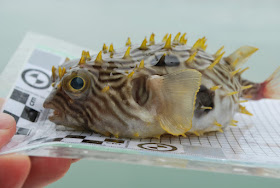Perhaps some of the most interesting and favorite organisms to catch while seining in seagrass beds are puffer and burrfish. Because both of these species can inflate themselves as a defense mechanism, they are often generally referred to as "puffers". There are, however, differences between the two, and in fact they come from different families.
Pufferfish are members of of tetraodontidae family. They do not have any visible spines on their skin. The "tetra" in the family name refers to the four large fused teeth (2 on the top 2 on the bottom) that are used help the fish feed on crustaceans and mollusks. While several species can be found in southwest Florida, one of the most common is the Southern pufferfish (Sphoeroides nephelus). They have a brown body which is paler below, and are adorned with a variety of darker and lighter spots and blotches. They also have tan rings and semicircles on their body. For a full description of the Southern pufferfish's biology and life history visit: http://www.sms.si.edu/irlspec/Sphoeroides_nephelus.htm
Burrfish are members of the diodontidae family. Unlike pufferfish they do have a series of spines covering their body. The "di" in the family name refers to the two large fused teeth (1 on the top and 1 on the bottom) that are used to help feed on crustaceans and mollusks. The most common burrfish species we see in southwest Florida is the striped burrfish (Chilomycterus schoepfii). They are light tan to yellow-brown above and white to yellowish and sometimes blackish below. In addition to spines that cover their body, they have a series of wavy and roughly parallel lines on the side of their body. For a full description of the striped burrfish's biology and life history visit:
http://www.sms.si.edu/irlspec/chilomycterus_schoepfii.htm





Crap. I've been calling Burrfish, pufferfish for 2 years now. Thanks for the facts.
ReplyDelete